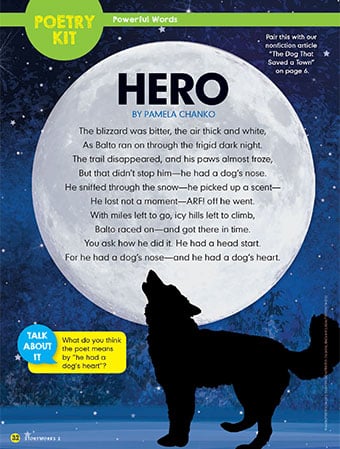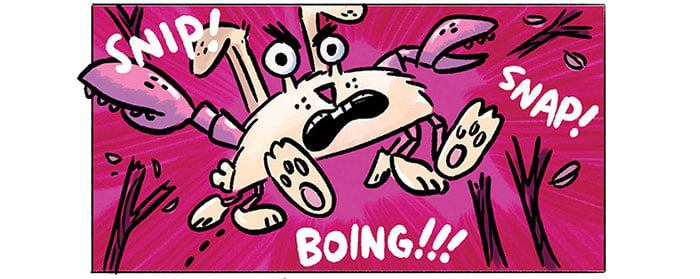- Storyworks 2 is full of amazing text-to-text connections to help kids gain context for what they’re reading. This article and our nonfiction article “The Dog That Saved a Town” on page 6 make
an incredibly powerful pair. - This poem also adds to the discussion for the essential question of this issue of Storyworks 2: What makes a hero? Reading and discussing “Hero” along with the other hero-themed texts in the magazine (the nonfiction article “The Dog That Saved a Town,” the mini graphic “The Playground Monster,” and the fiction story “The Space Rock”) should give kids great insight into what it means to be a hero in the world.
- Through the above genres, students will discuss: What traits do heroes have? How do heroes act? What does it mean to be a good person (or dog!)?

Hero
Pair this poem with our nonfiction article “The Dog That Saved a Town”.
More About the Article
Social-Emotional Learning Focus
Heroes; perseverance
Get Ready for Text-to-Text Connections!
1. Before Reading
Read the Nonfiction Article/Build Background (30 minutes)
- Kids will understand this poem best if they read the nonfiction article “The Dog That Saved a Town” on page 6 of this issue.
- That article tells the true story of Balto’s race to get lifesaving medicine to kids in 1920s Alaska. It comes with videos, printables, a vocabulary slideshow, and a lesson plan that make for an extremely rich reading experience.
2. Read the Poem (10 minutes)
- Explain that poems can express feeling in a short amount of space. Tell kids that they are going to read a poem about Balto that fits on just one page but really tugs at the heartstrings!
- As they read, they should pay attention to how the poem makes them feel.
- Read the poem as a class. Model fluency by reading it aloud first with as much emotion as you can muster.
- Then call on students to read it aloud, four lines each. Ask them to try to read with expression.
3. After Reading
ELA Focus: Comprehension/Idioms (10 minutes)
- Ask the question in the yellow box at the bottom of the page: “What do you think the poem means by ‘he had a dog’s heart’?”
- Explain that the idiom, or saying, “to have a lot of heart” means to be kind and passionate.
- You can talk about how Balto ran with “a lot of heart”—a lot of passion and courage.
ELA Focus: Compare Two Texts (15 minutes)
- Use our Compare Two Texts skills sheet to teach the article and poem as a pair.
ELA Focus: Rhyming Words (10 minutes)
- Do our Rhymes in Poems printable to give kids practice with rhyming words as a feature of poetry.
ELA Focus: Vocabulary and Text Evidence (20 minutes)
- Kids learned the word persevere in “The Dog That Saved a Town.” Use our printable “Balto Kept Going!” to get more practice with the word persevere as well as practice with text evidence.

Pair this poem with our nonfiction article “The Dog That Saved a Town”.
Multimedia
More About the Article
Heroes; perseverance
Get Ready for Text-to-Text Connections!
- Storyworks 2 is full of amazing text-to-text connections to help kids gain context for what they’re reading. This article and our nonfiction article “The Dog That Saved a Town” on page 6 make
an incredibly powerful pair. - This poem also adds to the discussion for the essential question of this issue of Storyworks 2: What makes a hero? Reading and discussing “Hero” along with the other hero-themed texts in the magazine (the nonfiction article “The Dog That Saved a Town,” the mini graphic “The Playground Monster,” and the fiction story “The Space Rock”) should give kids great insight into what it means to be a hero in the world.
- Through the above genres, students will discuss: What traits do heroes have? How do heroes act? What does it mean to be a good person (or dog!)?
1. Before Reading
Read the Nonfiction Article/Build Background (30 minutes)
- Kids will understand this poem best if they read the nonfiction article “The Dog That Saved a Town” on page 6 of this issue.
- That article tells the true story of Balto’s race to get lifesaving medicine to kids in 1920s Alaska. It comes with videos, printables, a vocabulary slideshow, and a lesson plan that make for an extremely rich reading experience.
2. Read the Poem (10 minutes)
- Explain that poems can express feeling in a short amount of space. Tell kids that they are going to read a poem about Balto that fits on just one page but really tugs at the heartstrings!
- As they read, they should pay attention to how the poem makes them feel.
- Read the poem as a class. Model fluency by reading it aloud first with as much emotion as you can muster.
- Then call on students to read it aloud, four lines each. Ask them to try to read with expression.
3. After Reading
ELA Focus: Comprehension/Idioms (10 minutes)
- Ask the question in the yellow box at the bottom of the page: “What do you think the poem means by ‘he had a dog’s heart’?”
- Explain that the idiom, or saying, “to have a lot of heart” means to be kind and passionate.
- You can talk about how Balto ran with “a lot of heart”—a lot of passion and courage.
ELA Focus: Compare Two Texts (15 minutes)
- Use our Compare Two Texts skills sheet to teach the article and poem as a pair.
ELA Focus: Rhyming Words (10 minutes)
- Do our Rhymes in Poems printable to give kids practice with rhyming words as a feature of poetry.
ELA Focus: Vocabulary and Text Evidence (20 minutes)
- Kids learned the word persevere in “The Dog That Saved a Town.” Use our printable “Balto Kept Going!” to get more practice with the word persevere as well as practice with text evidence.








Social-Emotional Learning Focus